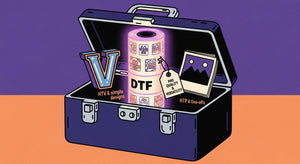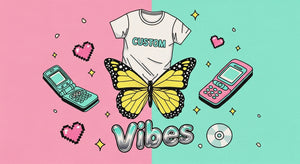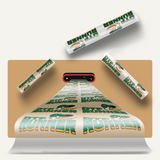Table of Contents
DTF printing is a new frontier in producing customized apparel and textiles. If you are a new user of this innovative way of printing, then this guide shall give an ideal introduction to DTF prints. Knowing how the very basics work and the benefits associated with DTF printing will empower you to create amazingly stunning custom designs. The basics of DTF printing, its advantages, equipment, and processes are all explained in this post. Then it gives tips for success, common challenges, and future trends.
How DTF Printing Works
The DTF printing process starts with creating a digital design using graphic design software. This design is then printed onto a PET film using a DTF printer. The printed film is coated with a special adhesive powder, which ensures the design adheres properly to the fabric. Once the adhesive is applied, the film is heated to cure the adhesive and prepare it for transfer. Finally, the film is pressed onto the fabric using a heat press, transferring the design from the film to the fabric.
Essential Equipment for DTF Printing
DTF Printer
The core of DTF printing is the DTF printer. These printers are specifically designed to handle the PET film and DTF inks required for the process. When choosing a DTF printer, consider factors like print resolution, speed, and compatibility with your design software.
Heat Press
A heat press is essential for transferring the printed design from the film to the fabric. The heat press applies the necessary heat and pressure to ensure a great transfer. Choose a heat press with adjustable temperature and pressure settings for optimal results.
PET Film and Adhesive Powder
PET film is the medium on which your design gets printed. Be sure to use high-grade PET film compatible with your DTF printer. Of importance is also the adhesive powder, which helps your design adhere well to the fabric. Make sure to use a strong adhesion, long-lasting powder.
Steps to Create DTF Prints

Designing Your Artwork
Start by creating your design using graphic design software. Ensure your design is high resolution, typically at least 300 DPI, to maintain clarity and detail. Save your design in a compatible format, such as PNG or JPEG.
Printing on PET Film
Load the PET film into your DTF printer and print your design. Make sure to follow the printer's instructions for settings and adjustments to achieve the best print quality.
Applying Adhesive Powder
After printing, sprinkle the adhesive powder on the printed side of the PET film. The powder should spread out totally to cover the design for proper adhesion.
Curing the Adhesive
Heat the film to cure the adhesive powder. This step is crucial as it activates the adhesive, making it ready for transfer. Follow the recommended temperature and time settings for your specific adhesive powder.
Transferring the Design
Place the cured film onto the fabric, design side down. Use the heat press to transfer the design, applying the recommended temperature and pressure. Once transferred, peel off the film to reveal your vibrant, durable DTF print.
Tips for Successful DTF Printing
Choosing the Right Fabrics
Select fabrics that are compatible with DTF printing. While DTF prints work well on various materials, some fabrics may require specific settings or additional steps to achieve the best results. Choosing the right fabric is very important to do a good job.
Experimenting with Colors
DTF printing allows for a wide range of colors. Experiment with different color combinations and designs to see how they translate onto fabric. Don't be afraid making experiment. Testing on fabric swatches can help you perfect your designs before final production.
Maintaining Your Equipment
This will help in having consistent quality. Ensure regular cleaning and maintenance of your DTF printer and heat press are observed to the best capacity by adhering to guidelines stipulated by the manufacturer.
Using High-Quality Inks
The quality of the inks used in DTF printing significantly impacts the final result. Invest in high-quality inks that offer vibrant colors and long-lasting durability. Poor-quality inks can lead to dull prints and reduced lifespan.
Proper Storage of Materials
Keep the PET film and adhesive powder in a dry, cool place. These products are compromised both by dampness and high temperatures.
Common Challenges and Solutions
Ink Smudging
Ink smudging can occur if the ink does not dry properly before applying the adhesive powder. Ensure adequate drying time or use a drying unit to prevent smudging.
Incomplete Transfers
This, in turn, can cause incomplete transfers in case the settings on the heat press are not correct. Check the temperature again, pressure, and time setting to make sure it is complete.
Adhesive Powder Issues
If the adhesive powder does not adhere evenly, the design may not transfer correctly. Ensure an even coating of adhesive powder and proper curing to avoid this issue.
Fabric Compatibility
Not all fabrics react the same way to DTF prints. Some fabrics might not hold the ink well or might require a different type of adhesive powder. Conduct tests on various fabric types to determine the best combinations for your projects.
Printer Maintenance
Clean up your DTF printer regularly to avoid clogging and maintain the quality of the prints. Follow maintenance instructions given by the manufacturer, and use recommended cleaning solutions and tools.
Future Trends in DTF Printing
Advances in Technology
With the continuous improvement in DTF printing technology, print quality, speed, and efficiency will keep improving. Newer models of DTF printers and heat presses are continuously coming out, with more advanced features and capabilities added.
Eco-Friendly Options
With growing environmental awareness, eco-friendly DTF printing solutions are becoming more popular. Look for printers and consumables that prioritize sustainability and minimize environmental impact. For a better world, you should make eco-friendly choices.
Customization and Personalization
The market is demanding more and more customized products, including personalization. In this regard, the DTF printer caters to this growing demand with its designs, all uniquely different from one another.
Integration with Other Technologies
Future advancements may see DTF printing integrating with other printing technologies, such as sublimation and DTG (Direct to Garment) printing. This integration can expand the range of possibilities for custom apparel design.
Software Improvements
Design software, specifically for DTF printing, will become more user-friendly and easy. This will simplify the process by offering better color management, design templates, and compatibility with different printers and materials.
Conclusion: DTF Prints
Direct to Film Printing offers a powerful and versatile solution for creating custom apparel and textiles. With its vibrant colors, fine details, and durability, DTF prints are a top choice for designers and businesses alike. By understanding the process, benefits, and essential equipment, you can harness the potential of DTF printing to bring your creative visions to life.
Stay informed of the latest trends and advanced technologies in DTF printing to help create more exceptional, high-quality, and creative designs. Prepare for the world of DTF printing and learn how this radical technology will make your custom apparel projects stand apart. Be it for personal or business use, DTF printing opens a host of endless possibilities for creating breathtakingly beautiful, wear-resistant, and vivid prints. We are very happy to help you with this guideline. Happy Printing!






